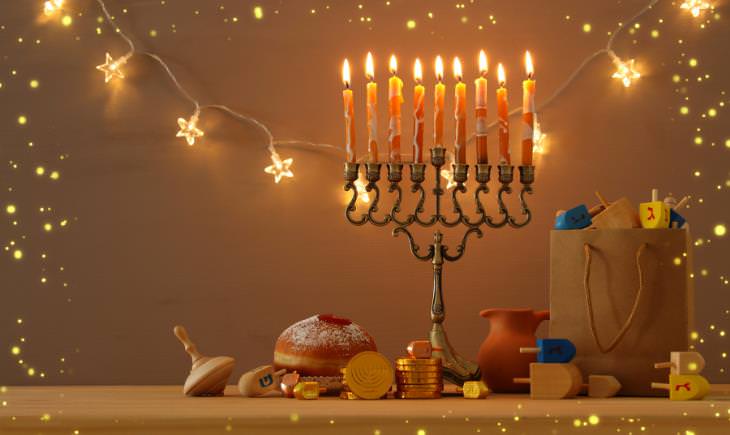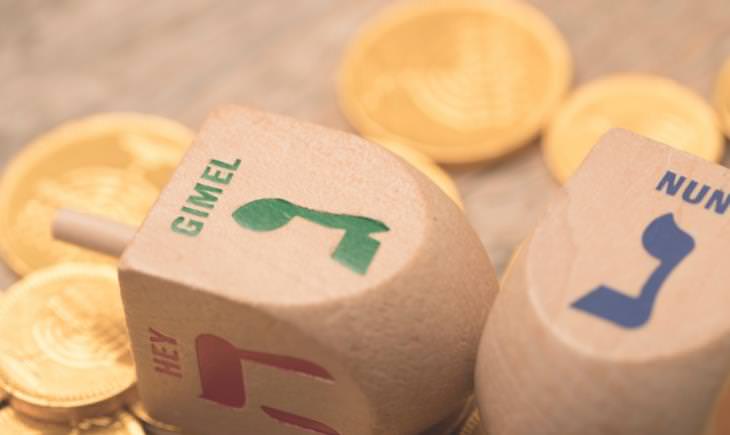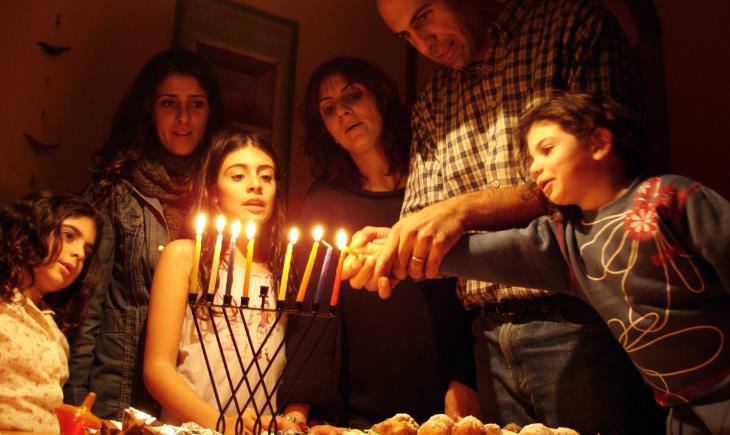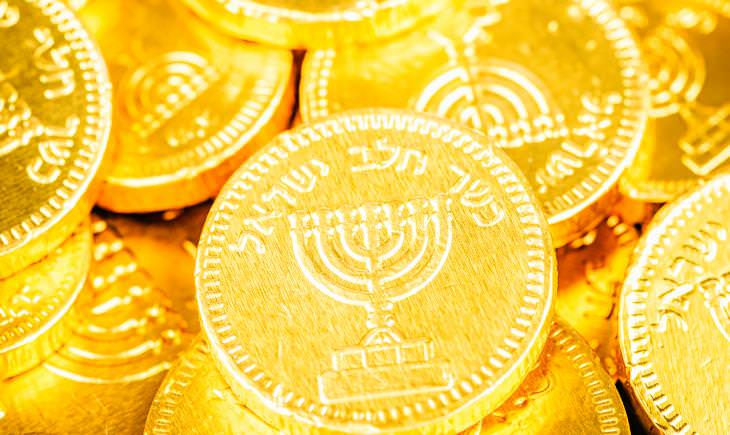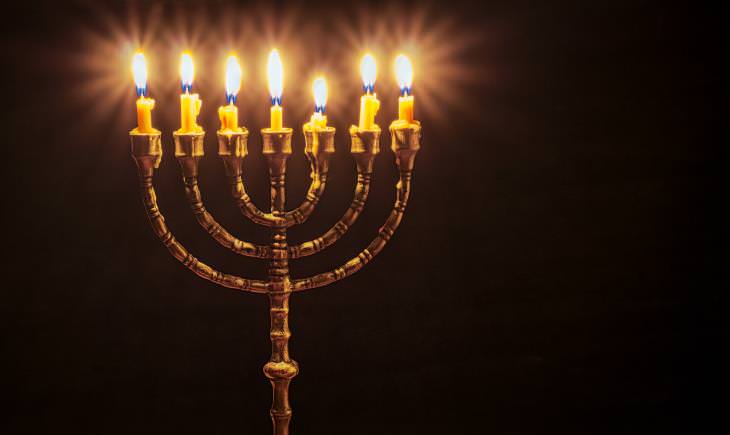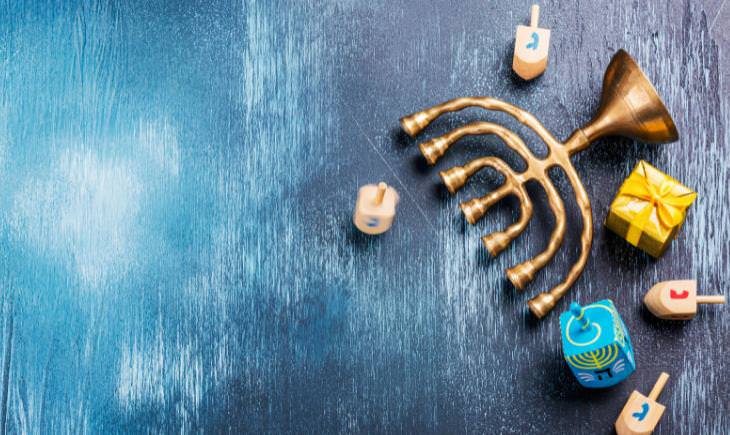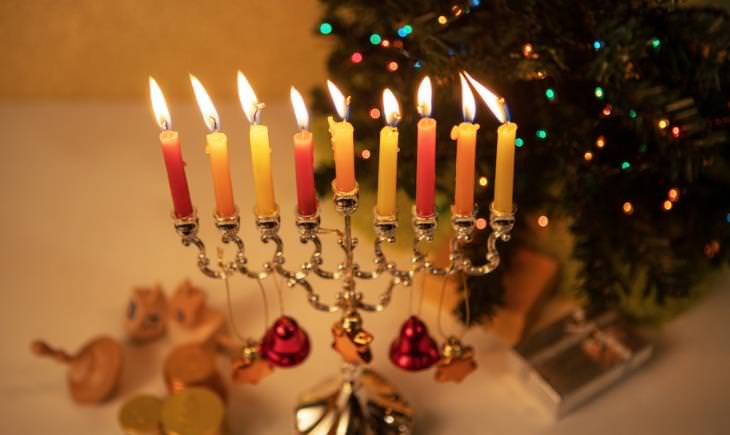Hanukkah has both historical and mythical roots
The holiday celebrates the victory of the Maccabees army over the Greeks. Led by Judah Maccabee and his 4 brothers, they restored the Holy Temple in Jerusalem to serve God and freed Judea from the occupation during the Second Temple period, over 2,000 years ago. These are the historical facts.
When the Maccabees set up a new Menorah in the Temple, they found one cruse of olive oil, enough to light the menorah for one day only. It is a lesser-known fact that a Menorah was always in the Temple, long before Hanukkah. As the myth has it, the oil miraculously lasted 8 days. Therefore, we light our menorahs 8 days each year.
The word Hanukkah has various meanings. In this instance, it means "dedication." Upon lighting and setting up a new Menorah in the Temple, the Maccabees rededicated the Temple to serve God and banished the Greek gods.
Hanukkah has its own set of customary foods
They are latkes (in Hebrew, levivot), jam-filled donuts (in Hebrew, sufganiyot), and kugel (a sweet noodle casserole). These are mostly deep-fried foods to commemorate the oil that burned in the Menorah. Although that was olive oil, modern recipes use vegetable oil.
Here's a latkes recipe by the New York Times. You can serve them with sour cream or sugar. The next two recipes are courtesy of my grandmother and mother. I hope you enjoy them as these were staples of my childhood. Here we go:
Sweet Noodle Kugel:
The key to a successful kugel is making sure that the top has browned enough, so it forms a crunchy crust.
Ingredients
- Noodles (flat wide ones are the best fit)
- 1/2 cup brown sugar
- 1/2 cup honey
- 1/2 cup vegetable oil
- 4 eggs
- 1 tsp cinnamon
- 1/2 tsp pepper
- 1 green apple, cut into small cubes
- Optional: 1 cup raisins.
Preparation
- Preheat oven to 320°F (160°C). Butter a deep casserole baking dish.
- Cook the noodles in salted water. Wash with cold water and add 2 tablespoons of vegetable oil.
- Cook the sugar, vegetable oil, and honey until everything melts. Pour over the noodles and mix well.
- Gradually add in the eggs, one by one. Don't stop stirring. Add the cinnamon, pepper, raisins, and apple.
- Cover with tin foil and bake for 2 - 2 and a half hours.
Homemade sour cream sufganiyot:
These are like small donut balls. They're fluffy with a crunchy crust, truly a guilty pleasure.
Ingredients
- 2 1/2 cups flour
- 2 tsp baking powder
- 2 eggs
- 14 oz sour cream
- 2 tbsp sugar
- 1 tsp vanilla extract
- a pinch of salt
- 1/2 gallon (2 liters) oil for deep frying in a pot.
Preparation
- Heat the oil in a pot. You'll need a minimum of 4'' (10 cm) of oil.
- Mix all the ingredients in one bowl. If it's too thick, you can add milk.
- Test the oil: dump a small drop of the batter into the hot oil. If it floats and fizzles, the oil is hot enough.
- Use a spoon to help you measure. Drop one spoon at a time into the oil. Be very careful.
- The balls usually turn by themselves. If they don't turn, do so yourself. Once brown, remove from the oil and let set on a wire rack or paper towel.
- Serve topped with jam or powdered sugar.
The letters on the dreidel form an acronym
The letters are Nun (sounds like N), Gimel (sounds like G in synagogue), Hey (sounds like H), Shin (sounds like SH). They stand for a sentence in Hebrew that means "a big miracle happened there": nes gadol haya sham. This refers to the little oil cruse that lasted a full 8 days, even though there was only enough for a day.
In Israel, the letters are a little different, since the miracle happened there, so the sentence reads nes gadol haya po, meaning "a big miracle happened here." Only one letter is different: instead of Shin, there's a Pe (sound like P).
The Jews under the ancient Greek occupation were banned from learning the Torah. They studied their Torah while pretending to gamble over dreidel-spinning gambling games.
The dates of the holiday are based on the Hebrew calendar
In Israel, the Hebrew calendar is mainly traditional. Everyday affairs are planned according to the Gregorian calendar, which is used (almost) worldwide. Hanukkah is celebrated each November, but the Gregorian date changes. This is because the holiday's date is based on the Hebrew calendar to be on every 25th day of the month of Kislev. Instead of using numbers, the days of the Hebrew months are counted by letters, and the months are based on the cycle of the moon.
Some give money instead of gifts
A well-known Hanukkah custom is to give money to children. This is sometimes referred to as the Hanukkah allowance or Gelt, the Yiddish word for money. Nowadays, mostly in the US, families give presents instead of money, and the children get coin-shaped chocolate, wrapped tightly in tin foil to resemble ancient gold coins.
The menorah we light today has more branches than the one from the Temple
As mentioned earlier in the article, a Menorah stood in the Temple long before the Hanukkah holiday had started. There is a difference between that holy Menorah and the one Jewish people light at home. The Menorah has 7 branches, as depicted in the picture above. What people light at home, also referred to as Hanukkiah, has 9 branches. The candles in both are considered holy and are not to be used for any other purpose but to spread light from the Hanukkiah. The middle candle in both the Menorah and the Hanukkiah is called Shamash. It is used to light the other candles.
Hanukkah is a home holiday
Hanukkah is celebrated mainly at home; there isn't a dedicated synagogue ritual for it. It isn't even included in the Torah. What may be arranged are candle-lighting communal gatherings. Each night, the family gathers around the table to light the menorah together and sing songs.
Hanukkah is not a Jewish version of Christmas
This is a common misconception rooted in the proximity of the dates. The mythological and historical roots of both holidays are entirely different, but many Jewish families outside of Israel celebrate both. While Hanukkah celebrates an army victory, religious freedom, and a mythical miracle, Christmas celebrates the birth of Jesus of Nazareth.

